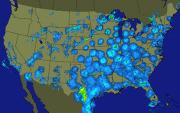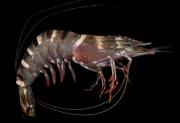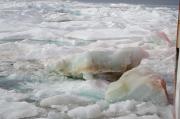Radio Program
Our regular Science and the SeaTM radio program presents marine science topics in an engaging two-minute story format. Our script writers gather ideas for the radio program from the University of Texas Marine Science Institute's researchers and from our very popular college class, Introduction to Oceanography, which we teach to hundreds of non-science majors at The University of Texas at Austin every year. Our radio programs are distributed at to commercial and public radio stations across the country.
Survival is all about change. Species that can adapt to changing conditions will live on, while those that can’t are doomed. That’s why a study released a couple of years ago may be good news for olive ridley sea turtles in the eastern Pacific Ocean. The study showed that the turtles go with the flow — they aren’t stuck in rigid patterns. In a world where the climate is changing in a hurry, that could help ensure the turtles’ survival.
Every spring, millions of visitors flock to the coasts of Texas and Louisiana. They gorge themselves for a few days before many of them head north — often all the way to Canada.
These visitors are birds — dozens of species that cross the Gulf of Mexico to reach their summer breeding grounds. And scientists and birdwatchers alike get early notice of the arrivals from radar — the same stations that are used to track the weather.
For the most part, the coastal regions of Texas and Louisiana are flat and featureless. The coastal plains slope gently upward from the Gulf of Mexico, with few hills and canyons to break up the flat terrain. And that trend continues far out into the gulf as well.
About a hundred miles offshore, though, the contours begin to change dramatically. Maps compiled from decades of measurements show hills, ridges, and canyons that make the Gulf floor look more like the Badlands of South Dakota than the Great Plains.
Humans aren’t the only creatures that move around the globe in a hurry. Many species of fish do, too. One indication of just how quickly they move came after the nuclear accident in Japan. Within months, fish with high concentrations of radioactive particles were showing up in the waters off the coast of California.
That grilled red snapper at your favorite seafood restaurant may be just what it’s supposed to be — a tasty fish caught in the Atlantic or Gulf waters of the United States. On the other hand, there’s a good chance it’s rockfish, tilapia, or cod. There’s also a good chance that anything labeled “grouper” is really imported catfish. And monkfish could be a potentially dangerous pufferfish.
If you like seafood, then you probably don’t think of “extra-jumbo” shrimp as a bad thing. But for the shrimping industry in the United States — not to mention native species of shrimp — those giant shrimp could cause a lot of problems.
It can happen to even the strongest swimmers. You’re splashing in the surf, enjoying the waves and sunshine, when you notice that you’re farther from shore than you should be. And as you tread water for a moment, you realize you’re being pushed out to sea. You’re a victim of something that’s found along almost every beach: a rip current.
The underside of a polar ice cap doesn’t sound like a very inviting abode for life. But a recent study found massive amounts of microscopic life beneath the Arctic ice — as much as scientists have seen anywhere in the entire oceans.
The rosy glow of a baby’s cheeks is considered a sign of good health. In the oceans, though, a rosy glow can be a sign of poor health — both of the glowing organisms, and of the entire marine ecosystem.
Falcons are among the most majestic creatures on Earth, soaring easily over mountains, forests, and other regions. For one species, the “other regions” include the icy waters around Greenland, where they can spend weeks at a time at sea.
Until recently, all falcons were thought to be strictly land-based. But a study released in 2011 found that gyrfalcons can range far out to sea.








